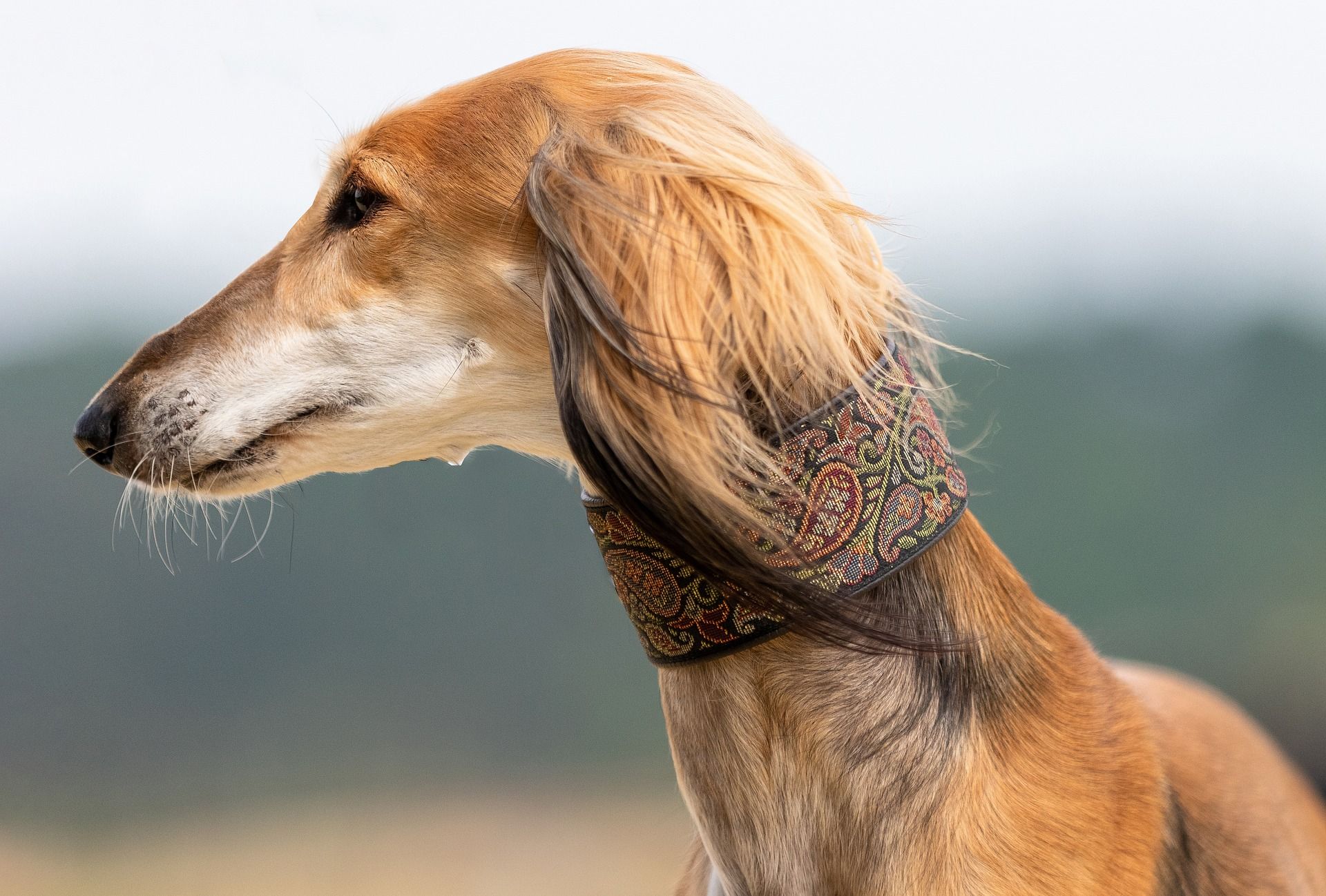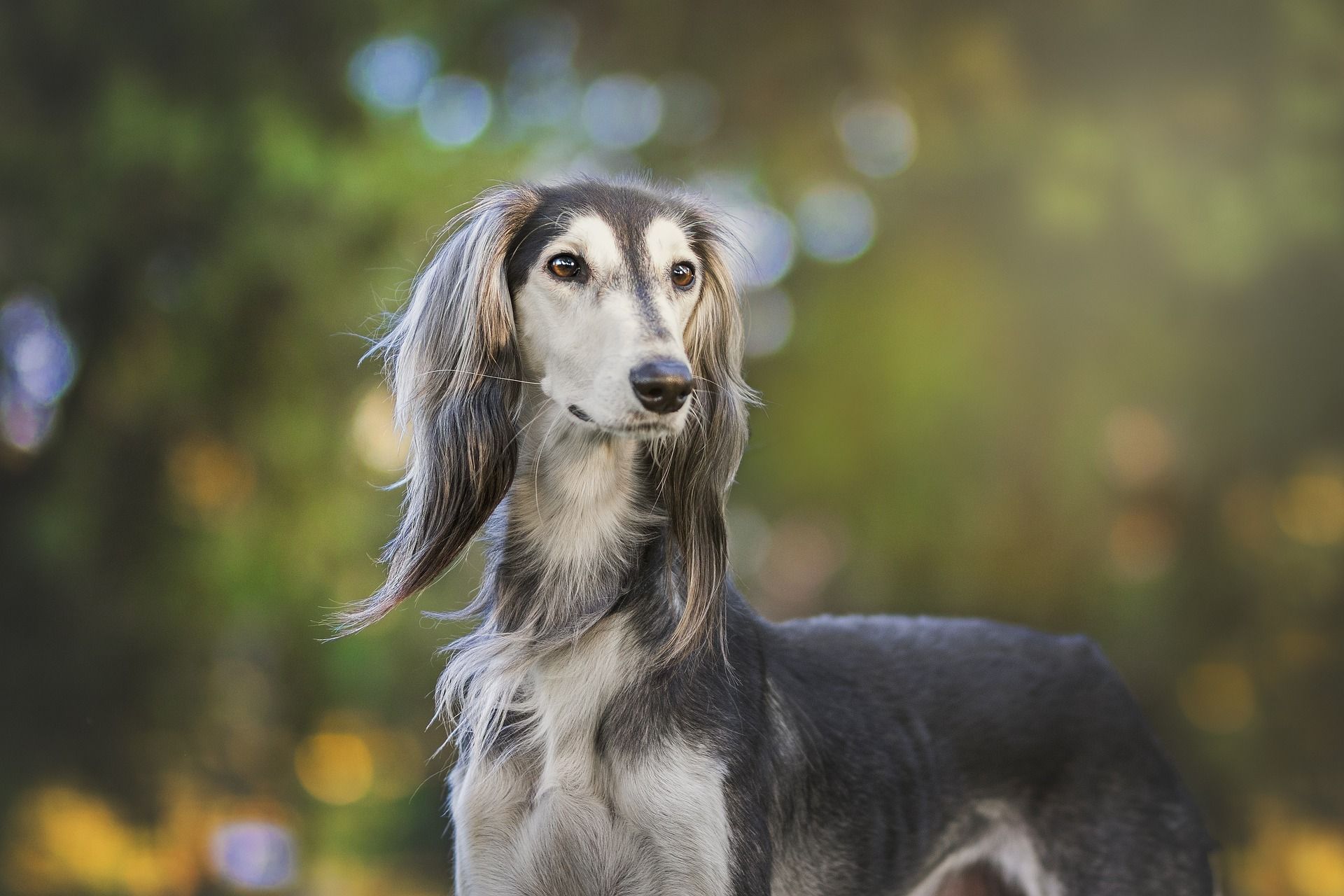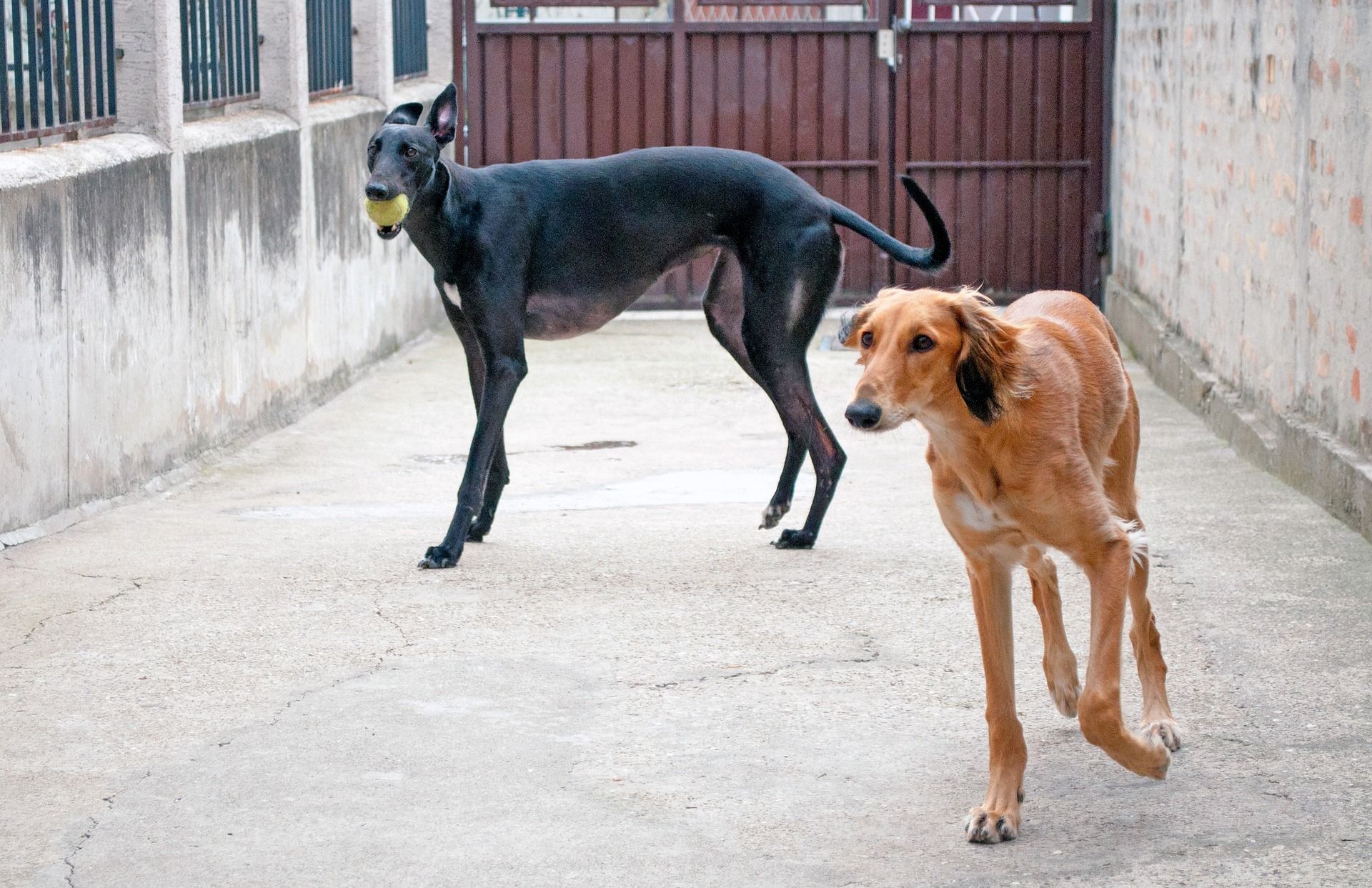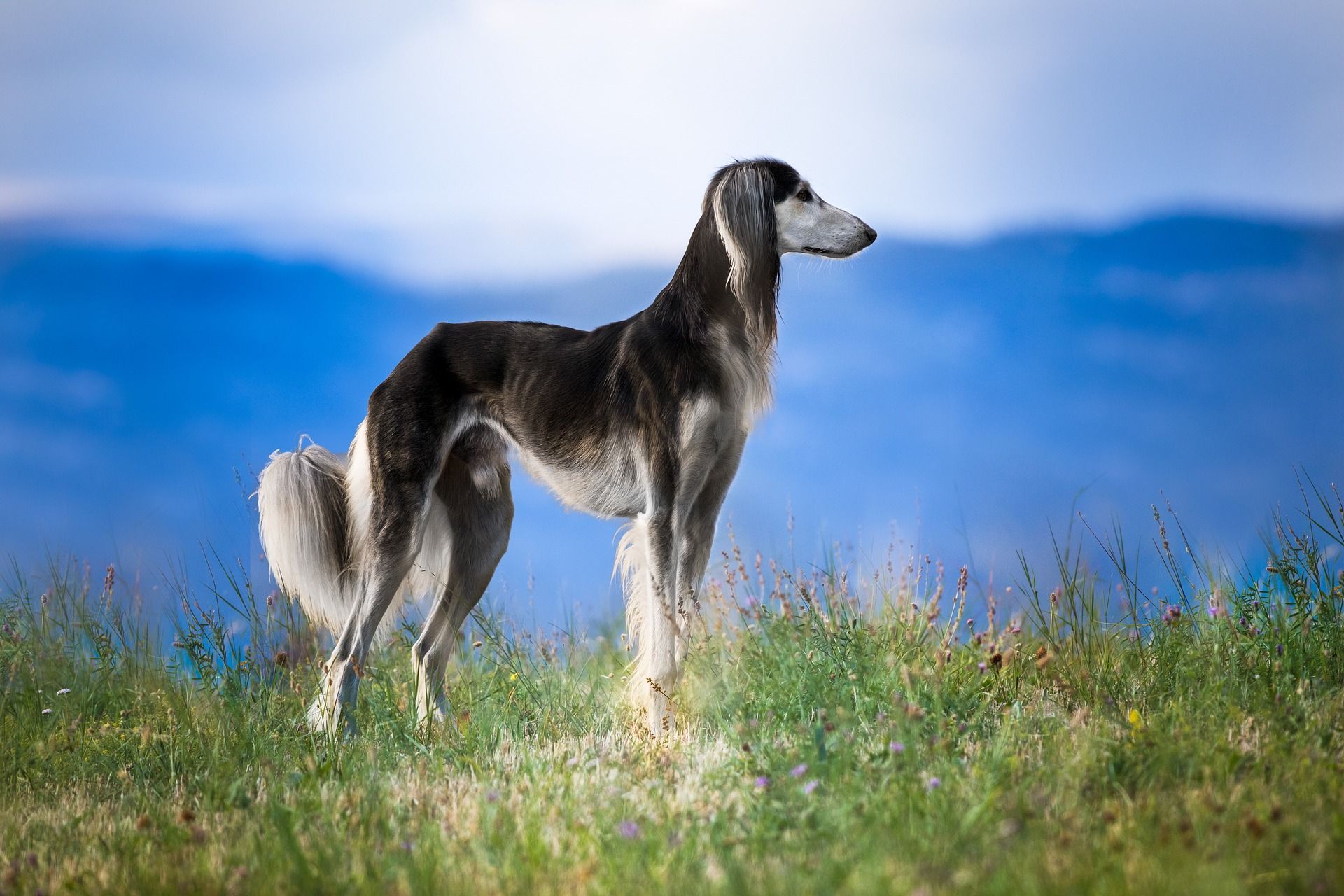One of the most defining features of the Saluki is its height but is it a large breed and how big does it get? It is larger than a Greyhound, for instance?
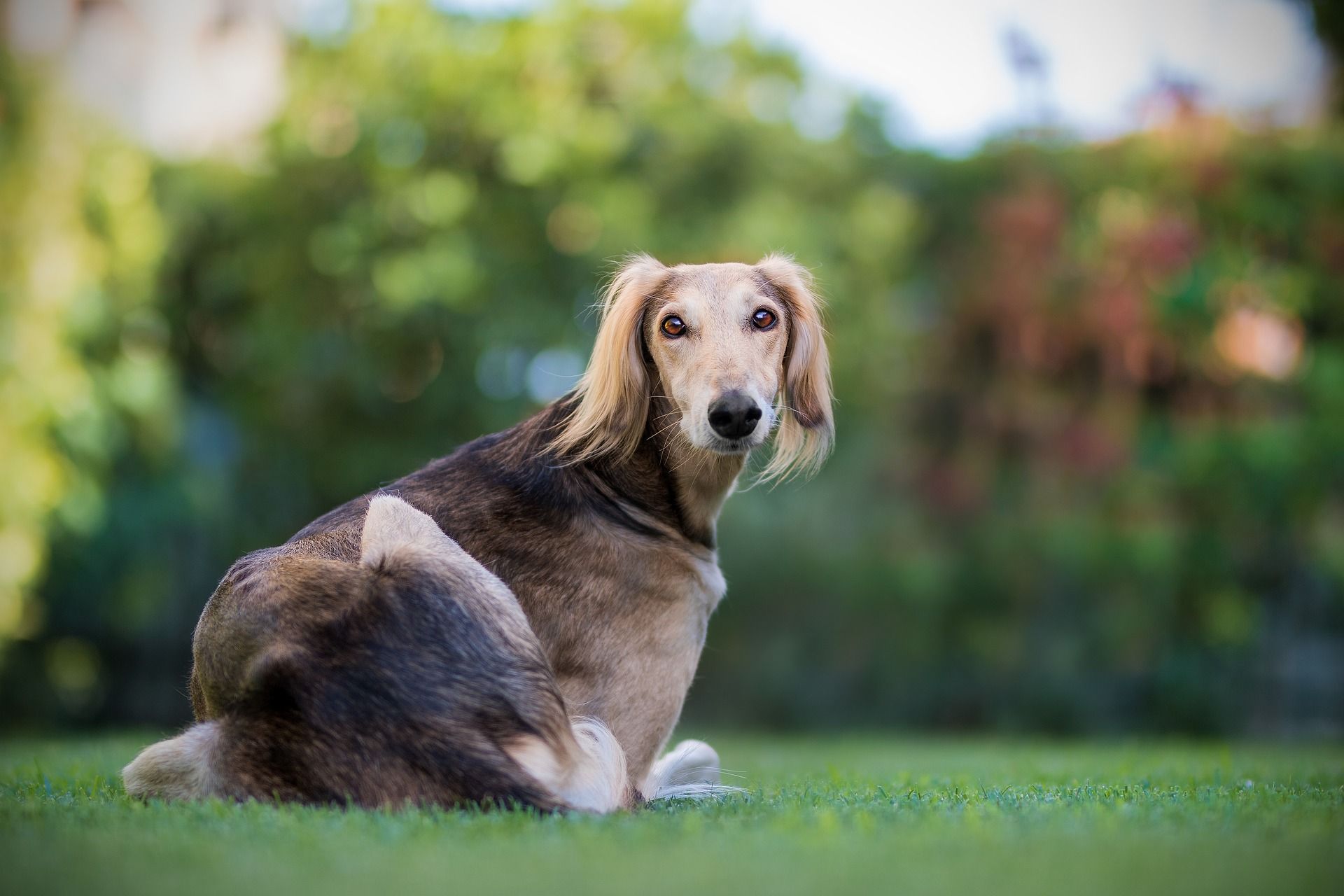
The Saluki, often referred to as the “Royal Dog of Egypt” due to its historical association with nobility and grace, stands out as a distinctive breed characterized by its sleek and elegant appearance. Is it considered a large breed?
Table of Contents
Is Saluki a large breed? How big they get?
Yes, the Saluki is considered a large breed of dog.
The size of individual Salukis can vary, but they generally fall into the category of large dogs.
Here are some considerations on the size and growth of Salukis:
Height
- Adult male Salukis typically stand between 23 to 28 inches (58 to 71 cm) tall at the shoulder.
- Adult female Salukis generally range from 21 to 26 inches (53 to 66 cm) in height.
Weight
- The weight of a Saluki can vary based on factors such as age, gender, genetics, and overall health.
- Adult male Salukis commonly weigh between 40 to 65 pounds (18 to 29 kg).
- Adult female Salukis typically weigh around 35 to 55 pounds (16 to 25 kg).
It’s important to note that Salukis are known for their slender and elegant build. While they are classified as a large breed, their physique is designed for speed and agility rather than bulk. Salukis have a unique appearance with a long, narrow head, a deep chest, and a sleek, athletic body.
Additionally, individual dogs may fall outside the typical size range, and factors such as genetics and nutrition can influence their growth. Regular veterinary check-ups and a balanced diet are essential for ensuring that a Saluki reaches and maintains a healthy size throughout its life.
Historical Context — Size as a Function
The Saluki’s size is not arbitrary but deeply rooted in its historical purpose. Originating in the Middle East, Salukis were bred for hunting and coursing in vast open terrains. The size of the Saluki was tailored to meet the demands of its primary role – swift pursuit of game.
Intentional breeding practices shaped the breed’s dimensions, emphasizing functionality over mere aesthetics.
Weight Considerations — Slenderness and Strength
While the Saluki is categorized as a large breed, its weight is marked by a balanced slenderness.
Males generally weigh between 40 to 65 pounds, and females typically range from 35 to 55 pounds.
The Saluki’s weight, while falling within the range of a large breed, is marked by a distinct balance, reflecting its historical role as a swift and agile hunter. This delicate interplay between slenderness and strength contributes significantly to the breed’s overall athleticism and grace.
Balanced Slenderness
The Saluki is renowned for its slender and sleek physique. While other large breeds may exhibit more robust or muscular builds, the Saluki’s body is finely tuned for speed and endurance.
This balanced slenderness is a direct reflection of the breed’s historical purpose as a sighthound, chasing game across expansive terrains. Their slender bodies reduce air resistance, allowing them to reach remarkable speeds in pursuit of prey.
The slenderness of the Saluki extends throughout its frame, from the elongated head to the narrow chest and lean musculature. This characteristic silhouette not only enhances their agility but also contributes to the breed’s overall aesthetic elegance.
Inherent Strength
Despite their slender appearance, Salukis possess inherent strength that is distributed strategically throughout their bodies.
This strength is evident in their well-developed musculature, particularly in the hindquarters and lower back, providing the power needed for explosive bursts of speed.
The breed’s strength is not about bulk but rather a lean and functional muscular structure. This design allows Salukis to navigate challenging terrains and execute swift turns while maintaining stamina during extended pursuits.
Their strength is a testament to the efficiency of form following function in the breed’s evolutionary history.
Weight Distribution and Agility:
Salukis exhibit a unique weight distribution that enhances their agility. The breed’s weight is concentrated where it matters most for optimal performance. The chest is deep and the body is streamlined, allowing for efficient movement without excess weight impeding their agility.
This strategic weight distribution is particularly crucial for a breed that historically relied on speed and precision in hunting. It enables Salukis to make rapid turns, accelerate quickly, and maintain endurance over long distances – characteristics that define their role as skilled sighthounds.
Adaptation to Hunting Environment:
The Saluki’s weight considerations are a result of adaptation to its hunting environment. In regions where the breed originated, the terrain often consisted of open deserts and plains.
The Saluki’s build reflects the need to navigate these terrains with efficiency, combining speed, endurance, and strength to capture elusive prey.
As guardians of the breed, understanding these weight considerations is essential for responsible ownership.
Providing proper nutrition, regular exercise, and veterinary care ensures that a Saluki can maintain its optimal weight, promoting overall health and well-being while preserving the breed’s unique combination of slenderness and strength.
Size at Different Growth Phases — Puppies to Adulthood
The size of a Saluki at different growth phases undergoes significant changes, reflecting the breed’s development from a delicate puppy to a fully mature adult.
Puppyhood: Birth to Six Months
- Size: Saluki puppies are born relatively small, and their size can vary depending on factors like genetics and litter size. At birth, they are delicate and require close care from the mother.
- Growth: During the first six months, Saluki puppies experience rapid growth. They go from being tiny and dependent on their mother’s milk to becoming more independent and exploring solid food. At the end of this phase, Saluki puppies are noticeably larger than when they were born.
Adolescence: Six Months to One Year
- Size: As Salukis transition from puppyhood to adolescence, their size continues to increase, although the growth rate starts to slow down. The slender and elegant characteristics of the breed become more pronounced.
- Growth: The focus during adolescence is on the development of bone structure and muscle mass. While the height growth may slow, the dog is still filling out, and its physique is becoming more refined.
Young Adulthood: One to Two Years
- Size: By the age of one, Salukis typically reach their full height. However, they continue to mature, and their bodies fill out, achieving a more balanced and adult appearance.
- Growth: Young adulthood is a stage where the Saluki’s overall physique becomes more defined. While the growth in height may have slowed, the body is still maturing in terms of muscle development and filling out.
Adulthood: Beyond Two Years
- Size: Salukis generally reach full maturity around two years of age. At this stage, their size stabilizes, and they have attained their adult height and weight.
- Growth: While there may be some minor changes in weight and muscle tone, the primary focus in adulthood is on maintaining optimal health. Adult Salukis showcase the breed’s distinctive features, characterized by their slender build and elegant proportions.
The size of the Saluki blends form and function. From its historical roots to the nuanced dimensions that contribute to its grace, the Saluki’s stature is a testament to intentional breeding practices and centuries-old roles.
Understanding the intricacies of their size not only deepens our admiration for this elegant breed but also serves as a guide for responsible ownership, ensuring that each Saluki thrives in optimal health and vitality within its unique dimensions.
Is a Saluki bigger than a Greyhound?
In general, Salukis and Greyhounds share many similarities, including their slender and elegant appearance, as both breeds are sighthounds.
While the height range of Greyhounds can overlap with that of Salukis,Greyhounds are often perceived as slightly larger and more robust. Additionally, individual dogs may fall outside the average size ranges for their breed.
It’s important to note that both Salukis and Greyhounds share a common sighthound heritage, and their size is optimized for speed and agility. However, there can be variations in size between individual dogs, and gender can also play a role in the size difference.
In terms of average size, both breeds are quite similar, but there can be some distinctions.
Saluki Size
- Salukis are considered a large breed, with males typically standing between 23 to 28 inches (58 to 71 cm) at the shoulder, and females ranging from 21 to 26 inches (53 to 66 cm).
- The weight of Salukis can vary, but on average, males weigh between 40 to 65 pounds (18 to 29 kg), and females weigh around 35 to 55 pounds (16 to 25 kg).
Greyhound Size
- Greyhounds are also a large breed, known for their tall and lean build. Adult males typically stand between 28 to 30 inches (71 to 76 cm) at the shoulder, and females stand between 27 to 28 inches (69 to 71 cm).
- The weight of Greyhounds is generally between 60 to 70 pounds (27 to 32 kg) for males and 55 to 65 pounds (25 to 29 kg) for females.
What dogs breeds are considered medium size?
Dog breeds that are considered medium-sized generally fall within a certain height and weight range. While definitions of “medium size” can vary, medium-sized dogs typically weigh between 30 to 60 pounds and stand around 18 to 24 inches tall at the shoulder.
Here is a list of dog breeds commonly categorized as medium-sized:
- Beagle
- Bulldog
- Cocker Spaniel
- Dachshund
- English Springer Spaniel
- French Bulldog
- Kelpie
- Poodle (Medium)
- Shiba Inu
- Siberian Husky
- Staffordshire Bull Terrier
- Border Collie
- Basset Hound
- Welsh Corgi (Pembroke)
- Bull Terrier
- Basenji
- Canaan Dog
- Keeshond
- Samoyed
- Whippet
It’s important to note that individual dogs within a breed can vary in size, so specific dogs may fall outside the typical size range for their breed.
Additionally, size alone does not necessarily determine a dog’s exercise needs, temperament, or suitability for a particular living situation.
Which dog breeds are considered large?
Large dog breeds are generally characterized by their substantial size, both in terms of height and weight. While definitions of “large” can vary, large dog breeds typically weigh over 50 pounds and can stand anywhere from 21 inches to well over 30 inches tall at the shoulder.
Here is a list of dog breeds commonly considered large:
- German Shepherd
- Golden Retriever
- Labrador Retriever
- Rottweiler
- Doberman Pinscher
- Boxer
- Great Dane
- Saint Bernard
- Newfoundland
- Mastiff
- Bernese Mountain Dog
- Akita
- Siberian Husky
- Alaskan Malamute
- Dalmatian
- Collie
- Rhodesian Ridgeback
- Irish Wolfhound
- Weimaraner
- Borzoi
Large dog breeds often have specific needs, including ample space, regular exercise, and proper training. Potential owners should consider the breed’s characteristics and ensure that they can meet the requirements for care and maintenance.
How much space does a Saluki need?
While they are adaptable to living in various environments, providing sufficient space is essential to meet their physical and mental needs.
Here are considerations regarding the space requirements for Salukis:
- Backyard size: Ideally, a Saluki should have access to a securely fenced backyard with enough space for them to move around freely. The size of the yard will depend on factors such as the individual dog’s energy levels, but a larger yard is generally beneficial.
- Secure fencing: Salukis have a strong prey drive and are capable jumpers. Therefore, it’s crucial to have a securely fenced area to prevent them from chasing after potential prey or escaping. A fence of at least 5 to 6 feet in height is recommended to discourage jumping.
- Daily exercise: Salukis require regular exercise to maintain their health and well-being. Daily walks, runs, or playtime in a spacious area are essential. They enjoy stretching their legs and running at high speeds, so having access to an open area or dog park can be beneficial.
- Indoor living: While Salukis appreciate outdoor activities, they are also adaptable to indoor living. However, living in an apartment or smaller space may require more intentional and regular exercise to ensure they get the physical activity they need.
- Mental stimulation: In addition to physical exercise, Salukis benefit from mental stimulation. Interactive toys, puzzle feeders, and activities that engage their minds are essential to prevent boredom and destructive behaviors.
- Supervised off-Leash areas: Salukis may enjoy off-leash time in secure and supervised areas. This could be a fenced dog park or a safe, open space where they can run and explore freely.
- Consideration for living conditions: Salukis can adapt to various living conditions, including urban environments, as long as their exercise needs are met. Living in an apartment may require more commitment to daily walks and playtime.
- Weather considerations: Salukis have short coats, and their tolerance to extreme weather conditions may vary. In hot weather, provide shade and ensure they stay hydrated. In colder weather, a Saluki may appreciate a warm and comfortable indoor space.

